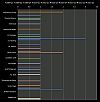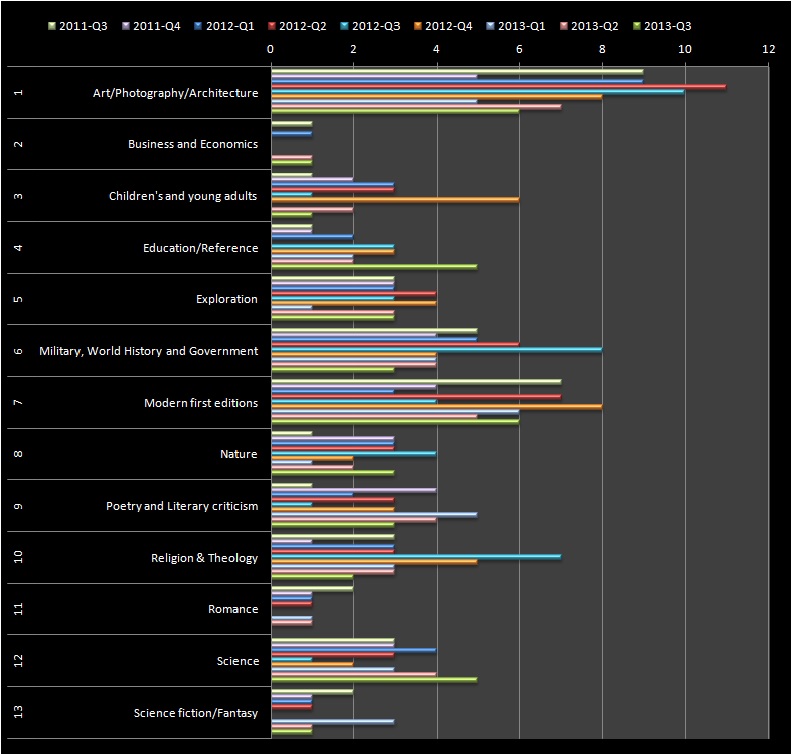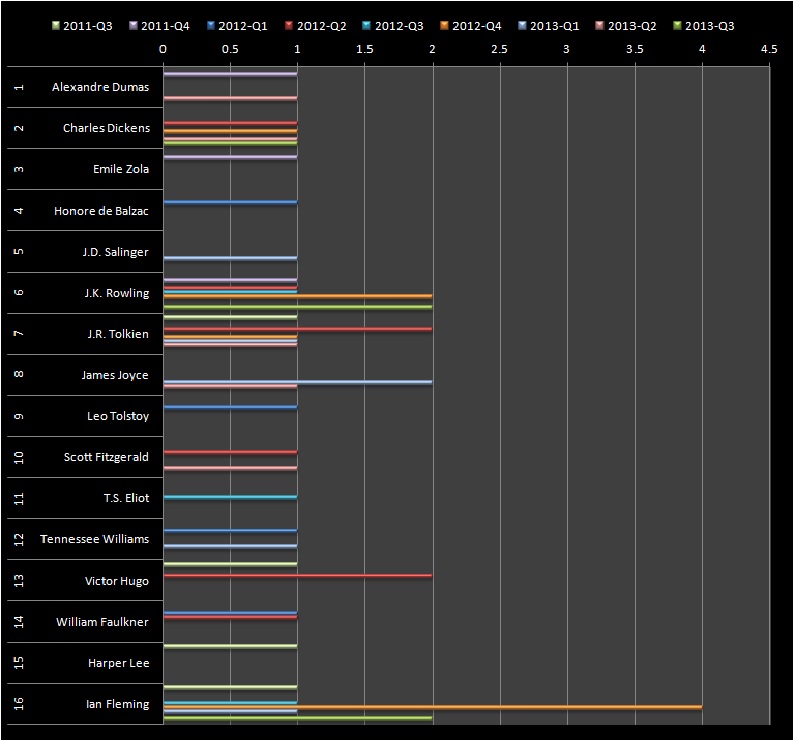As every statistician or analytics professional in today’s environment can affirm, collecting the information is crucial, but not enough, since most of data’s value lies in its use. While information is getting increasingly complex and there is certainly more of it, technology is actually helping unearth some of the insights hidden in the raw data collected. Our Rare Book Sale Monitor (RBSM) can readily produce insights that can be consumable by a variety of rare book trade professionals, collectors and hobbyists alike. For instance, in previous quarters, the RBSM reported an above normal price increase in collectible works by authors such as Ian Fleming and J.K. Rowling, and a consistent increase in interest for the books about “science,” in a trend that first began during the 3rd Quarter of last year.
In order to bring you the RBSM findings, we start with a list of every book sale in the genre of interest for each quarter, and feed in information such as the price of the sale, the category and the description, and compare that against five years of similar data ranked by condition and special attributes in order to identify the books that are correlated and comparable. As previously described, the heterogeneous, imperfect antiquarian book trade is quite challenging compared to other marketplaces that carry identical products or products that are by nature quite homogeneous.
One challenge of the rare book marketplace is accurately ranking the condition of a used book along with any of its accompanying publisher housing, such a dust jacket or slipcase. Our ranking is based on the Independent Online Booksellers Association (IOBA) book condition definitions, which are provided as follows:
A> AS NEW; FINE; MINT: Without faults or defects.
B> NEAR FINE: a book approaching FINE (or AS NEW or MINT) but with a couple of very minor defects or faults, which must be noted.
C> VERY GOOD: A book showing some signs of wear. Any defects or faults must be noted.
D> GOOD: The average used book is totally complete (as issued) and intact. Any defects must be noted.
E> FAIR: A worn book that has complete text pages (including those with maps or plates), but may lack endpapers, half-title page, etc. Any defects or faults must be noted.
F> POOR or READING COPY: A book that is sufficiently worn; its only merit is the complete text, which must be legible. Any missing maps or plates must be noted. May be soiled, scuffed, stained, or spotted, and may have loose joints, hinges, pages, etc.
Based on these groupings, the RBSM parses the description of each book used in the analysis for keywords (excluding any negated keywords), that have been tagged under one of the IOBA definitions. The following list contains some of the keywords currently being used in each of the groupings listed above:
A> New, as new, like new, fine, mint, fresh, bright, unfaded.
B> Light rubbing, some nicking, light edge wear, tiny closed tear, light fraying, lightly worn.
C> price clipped, creasing, soiled, faded, closed tears, chipped, bumped corners, faded spine, light foxing, sunning, edge wear, fray, nicks, dull, presentable, slight offsetting.
D> Stained, torn, previous owner’s (signature, name, address), heavy foxing, piece missing, with faults, repaired, highlighting, remainder mark, restoration, repairs, tears, offsetting, cocked.
E> Torn gutters, separating, no dust jacket, stamped, as is, loose binding, loose page, lacking end paper, detached but present.
F> Missing page, split, separated, broken hinge, lacking, poor condition, ex-library, detached.
The ranking algorithm uses weights applied to each keyword, as well as a measure of frequency of occurrence in order to compute a book’s final IOBA grade.
While ranking a book’s condition may seem quite trivial, the overall process is not limited to simply standardizing the factor of condition. A much bigger challenge is the factor of special attributes such as signatures, inscriptions, associations, bookplates and so forth. For a description of how the RBSM is interpreting, ranking and evaluating some of these and other special attributes found in a particular copy, please be sure to check back to a future posting.




{ 3 comments… read them below or add one }
I have a copy of the Charles Dickens book “A Christmas Carol” it has an inscription in the front dated
1912 to a friend in Swansea, England. Its a small blue book measuring 6 1/2″ tall by 4 1/14″ wide by
1/2″ thick. It’s a hard covered little book. On the front is embossed Everett’s Library. I do not know
when this was printed or if it is worth anything other than by the personal inscription it’s now
102 years of age in nice condition I believe. I am Canadian so this little book has travelled a long way.
Any information anyone can give to me would be greatly appreciated. Thank you
I found an 1891 version of Second Lessons in Arithmetic Henry Wheeler. Is it worth anything?
First edition was published in 1888. The 1891 reprint is also quite scarce.
{ 1 trackback }